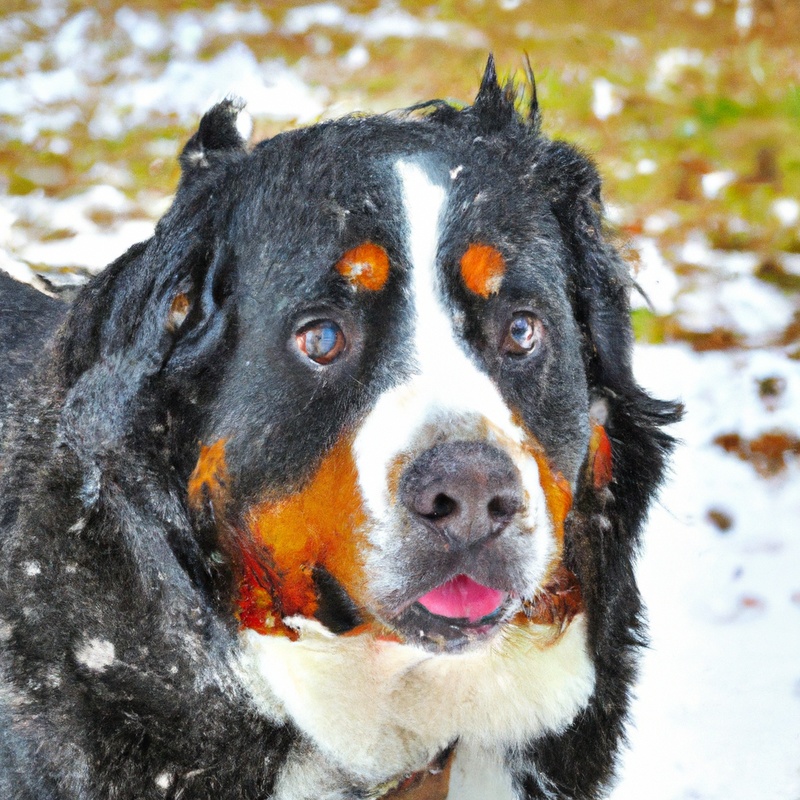How Do I Prevent My Bernese Mountain Dog From Chasing Wildlife?
Key Takeaways:
- Consistently train and reinforce the “leave it” command to discourage your Bernese Mountain Dog from chasing wildlife.
- Use positive reinforcement and rewards to redirect your dog’s attention away from wildlife and towards more appropriate activities.
- Ensure your Bernese Mountain Dog gets regular exercise and mental stimulation to help reduce the desire to chase wildlife.
- Utilize physical barriers such as fences or leashes to prevent your dog from having access to wildlife in the first place.
Does your Bernese Mountain Dog have an undeniable urge to chase wildlife, making your walks a constant battle of tug-of-war?
It can be frustrating, not to mention dangerous for both your pup and the wildlife they’re fixated on.
As an expert in dog behavior and training, I understand the importance of addressing this instinctual behavior early on.
In this article, I’ll share effective techniques to help you prevent your Bernese Mountain Dog from chasing wildlife.
From training and socialization to managing the environment and providing adequate exercise, we’ll cover all the bases.
So, let’s dive in and reclaim peaceful walks without compromising your pup’s safety!
| Methods | Effectiveness | Pros | Cons |
|---|---|---|---|
| Training and Socialization | High |
|
|
| Leash Walking | Medium |
|
|
| Positive Reinforcement | Medium |
|
|
| Physical Barriers | High |
|
|
Understanding the Instinct
Why do Bernese Mountain Dogs Chase Wildlife?
Bernese Mountain Dogs have a strong instinct to chase wildlife because of their heritage as working dogs in Switzerland. These dogs were originally bred to help with herding and guarding livestock, and their instinct to pursue and chase smaller animals is still very much present.
It’s important to understand that this behavior is natural for them and not something they can easily suppress.
The Dangers of Allowing the Behavior
Allowing your Bernese Mountain Dog to chase wildlife can pose several dangers. Firstly, it can put your dog at risk of injury, as they may run into unfamiliar territory or encounter aggressive animals.
Secondly, wildlife may carry diseases that can be transmitted to your dog through bites or scratches.
Additionally, allowing chasing behavior can disrupt ecosystems and harm the wildlife populations. It is vital to train and redirect your dog’s instincts to ensure their safety and the well-being of wildlife.

Importance of Preventing Wildlife Chasing
Preventing wildlife chasing is important for the safety of both your Bernese Mountain Dog and the wildlife.
It helps avoid potential injuries to your dog and reduces the risk of spreading diseases.
Additionally, preventing wildlife chasing helps protect the natural habitat and maintains the balance of the ecosystem.
Training your dog to refrain from chasing wildlife ensures a harmonious coexistence between your pet and the environment.
Training and Socialization Techniques
Basic Obedience Training
Basic obedience training is essential for preventing your Bernese Mountain Dog from chasing wildlife.
Start with simple commands like sit, stay, and come.
Use positive reinforcement, such as treats and praise, to reward your dog for good behavior.
Consistency is key, so practice these commands daily in different environments.
Use a leash or long line to prevent your dog from running off when training outdoors.
Gradually introduce distractions to improve your dog’s focus and impulse control.
Remember to be patient and consistent, and seek professional help if needed.

Recall Training
Recall training is essential for preventing your Bernese Mountain Dog from chasing wildlife.
Start by choosing a recall command, such as “come” or “here,” and use it consistently during training.
Begin in a quiet, distraction-free environment and reward your dog with treats and praise when they come to you.
Slowly increase the level of distractions and practice in different locations.
Avoid punishments and keep training sessions short and positive.
Gradually, your dog will learn to come back to you, even around tempting wildlife.

Desensitization and Counter-Conditioning
Desensitization and counter-conditioning are key techniques in preventing your Bernese Mountain Dog from chasing wildlife.
Desensitization involves gradually exposing your dog to the presence of wildlife at a distance, starting with low-intensity stimuli and gradually increasing the intensity.
Counter-conditioning focuses on changing your dog’s emotional response to wildlife by associating their presence with positive experiences, such as treats or playtime.
Consistency and patience are crucial when implementing these techniques, as they can help your dog learn to ignore and remain calm around wildlife.
Proper Socialization
Proper socialization is essential for preventing your Bernese Mountain Dog from chasing wildlife. Start early by exposing them to various environments, sounds, and people.
Encourage positive interactions with other animals to teach them appropriate behavior.
Use controlled introductions and reward good behavior with treats and praise. Gradually increase the level of distractions to reinforce their training.
Regularly engage in activities that build trust and strengthen the bond between you and your dog.
Consistency and patience are key throughout the socialization process.
Managing the Environment
Secure Fencing and Enclosures
One of the most effective ways to prevent your Bernese Mountain Dog from chasing wildlife is to secure your property with proper fencing and enclosures.
Here are some important tips to consider:
- Choose the right height: Make sure the fence or enclosure is high enough to prevent your dog from jumping over it. A minimum height of 5 to 6 feet is recommended.
- Secure the bottom: Dogs can dig under fences, so it’s important to secure the bottom to prevent escapes. Consider burying chicken wire or using concrete along the base.
- Use sturdy materials: Opt for durable materials like wood, metal, or vinyl for the fence or enclosure. Regularly inspect and repair any damages or weak spots.
- Check for gaps: Regularly inspect the fence for any gaps or holes that your dog could squeeze through. Patch them up promptly to maintain a secure environment.
- Create a secure play area: If your property is not fully fenced, consider creating a secure play area where your dog can safely enjoy outdoor time. Use sturdy, enclosed dog pens or kennels.
Remember, a secure fence or enclosure is vital for keeping your Bernese Mountain Dog safe and preventing them from chasing wildlife.
Regular maintenance and inspections are key to ensuring its effectiveness.
Supervised Outdoor Time
Supervised outdoor time is essential for preventing your Bernese Mountain Dog from chasing wildlife. When you’re with your dog outside, you can closely monitor their behavior and redirect their attention when they show an interest in chasing.
Keep them on a leash or in an enclosed area, such as a fenced yard, to prevent them from running after animals.
Additionally, providing plenty of mental and physical exercise indoors can help reduce their desire to chase wildlife when they do go outside. Regular training sessions can also teach them commands like “leave it” or “stay” to further reinforce their impulse control.
Using a Leash or Long Line
Using a leash or long line is essential for preventing your Bernese Mountain Dog from chasing wildlife. It gives you the control you need to keep them safe and avoid any dangerous or destructive behavior.
When using a leash, make sure it is sturdy and the appropriate length for your dog’s size and strength.
A long line allows them more freedom to explore, but still keeps them under your control. Make sure to supervise your dog at all times when using a long line, and avoid letting them off-leash in areas where wildlife is present.
Providing Adequate Exercise and Mental Stimulation
Daily Walks and Physical Activities
To prevent your Bernese Mountain Dog from chasing wildlife, daily walks and engaging in physical activities are essential. By providing regular exercise, you can help fulfill their energy needs and reduce their desire to chase.
Take your dog on long walks, allowing them to explore new smells and sights.
Incorporating activities like playing fetch or agility training can also help in keeping them mentally stimulated and physically tired. Remember, a tired dog is a happy dog!
Engaging Toys and Puzzle Games
Engaging toys and puzzle games are excellent tools to prevent your Bernese Mountain Dog from chasing wildlife.
Interactive toys, such as treat-dispensing balls or puzzle toys, can keep them mentally stimulated and entertained.
These types of toys require your dog to figure out how to access the treats, keeping their mind engaged and preventing boredom.
Additionally, toys that encourage active play, like tug-of-war ropes or squeaky toys, can help redirect your dog’s natural instinct to chase towards appropriate objects.
Just make sure to provide a variety of toys to keep them engaged and rotate them regularly to avoid boredom.
Mental Enrichment Activities
To mentally stimulate your Bernese Mountain Dog and prevent them from chasing wildlife, here are a few enrichment activities you can try:
- Puzzle toys: Invest in puzzle toys that require your dog to problem solve and work for treats or rewards. This engages their mind and keeps them entertained.
- Nose work: Hide treats or toys around the house or in the yard and encourage your dog to use their nose to find them. This taps into their natural scenting abilities and provides mental exercise.
- Training sessions: Teach your dog new tricks or commands to keep their mind sharp. Use positive reinforcement techniques and make training sessions fun and rewarding for them.
- Interactive play: Play games that require your dog’s mental engagement, such as hide-and-seek or tug-of-war. This adds a cognitive element to their playtime and helps satisfy their natural instincts.
Remember, mental enrichment activities are essential for your Bernese Mountain Dog’s overall well-being and can help redirect their focus away from chasing wildlife.
Keep them mentally stimulated and engaged to prevent unwanted behaviors.
Seek Professional Help if Necessary
Consulting a Professional Dog Trainer
If you’re having trouble preventing your Bernese Mountain Dog from chasing wildlife, consulting a professional dog trainer can be a great solution. They have the knowledge and experience to help address this specific behavioral issue.
A trainer will work with you and your dog to develop appropriate training techniques and strategies.
They can provide personalized guidance, tips, and exercises to help redirect your dog’s behavior and teach them to ignore wildlife. With their expertise, you’ll be on the right track to keeping your dog from chasing wildlife.
Working with a Behavioral Specialist
Working with a behavioral specialist can be extremely helpful when it comes to preventing your Bernese Mountain Dog from chasing wildlife. A specialist will have the expertise and experience to assess your dog’s behavior and develop a customized training plan.
They can provide you with valuable techniques and strategies to redirect your dog’s focus and discourage chasing behavior.
Additionally, they will be able to address any underlying issues that may be contributing to the behavior. Seek a professional for guidance.
Frequently Asked Questions
Can Bernese Mountain Dogs be trained to not chase wildlife?
Yes, Bernese Mountain Dogs can be trained to not chase wildlife.
With consistent and patient training, you can teach your Bernese Mountain Dog to respect and avoid wildlife.
Start by using positive reinforcement techniques, such as treats and praise, to reward your dog for ignoring wildlife and focusing on you.
Gradually expose your dog to controlled encounters with wildlife, using commands like “leave it” or “stay”.
It’s important to always supervise your dog when in areas with wildlife and reinforce their training regularly.
How long does it take to prevent wildlife chasing behavior?
Preventing wildlife chasing behavior in your Bernese Mountain Dog can be a challenging task. The time it takes to fully prevent this behavior can vary depending on various factors.
It may take weeks or even months of consistent training and reinforcement to effectively stop your dog from chasing wildlife.
The key is to be patient, consistent, and persistent in your training efforts. It’s important to consult with a professional dog trainer or behaviorist to develop a customized training plan for your specific dog and situation.
Remember, every dog is unique, so the timeline for preventing this behavior may differ.
Are there any specific training tools or equipment recommended?
To prevent your Bernese Mountain Dog from chasing wildlife, there are a few training tools and equipment that can be helpful.
One option is a long leash or a retractable leash, which can give you better control over your dog during walks.
Another tool is a whistle or an audible deterrent that can be used to distract and redirect your dog’s attention.
Additionally, using positive reinforcement techniques and reward-based training methods can be very effective in teaching your dog to ignore wildlife.
Be sure to consult a professional dog trainer for more guidance and advice specific to your dog’s needs.
What should I do if my Bernese Mountain Dog continues to chase wildlife despite training efforts?
If your Bernese Mountain Dog continues to chase wildlife despite training efforts, here are some strategies you can try:
- Increase exercise: Make sure your dog is getting enough physical and mental stimulation through walks, playtime, and training sessions. A tired dog is less likely to be interested in chasing wildlife.
- Use distractions: Carry treats or a favorite toy to redirect your dog’s attention when you see them starting to chase. Engaging them in an alternative activity can help break the chasing habit.
- Create boundaries: Use leashes, fences, or designated areas to limit your dog’s access to wildlife-prone areas. This will prevent opportunities for chasing and reinforce the idea that certain spaces are off-limits.
- Seek professional help: If despite your efforts, your dog’s chasing behavior persists, consider consulting a professional dog trainer or behaviorist. They can assess the situation and provide customized guidance to address the issue effectively.
Remember that consistency and patience are key when modifying your dog’s behavior. Keep reinforcing positive behaviors and providing appropriate outlets for their energy.
Final Verdict
It is crucial to understand why Bernese Mountain Dogs have a natural instinct to chase wildlife and the potential dangers this behavior can pose.
By utilizing effective training and socialization techniques, managing the environment, providing adequate exercise and mental stimulation, and seeking professional help if necessary, we can prevent our Bernese Mountain Dogs from chasing wildlife.
It takes time, patience, and consistency, but with the right approach, we can successfully redirect their instincts and ensure their safety, as well as the well-being of wildlife.
Remember, seeking professional guidance and being proactive in training is key to achieve the desired results.







